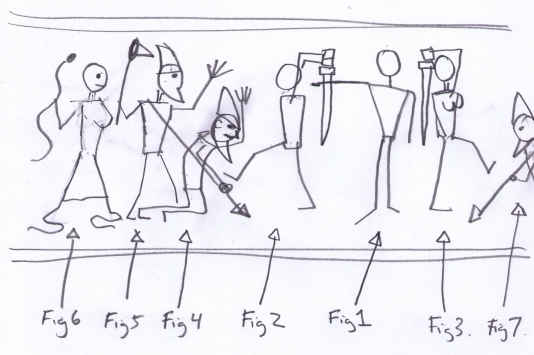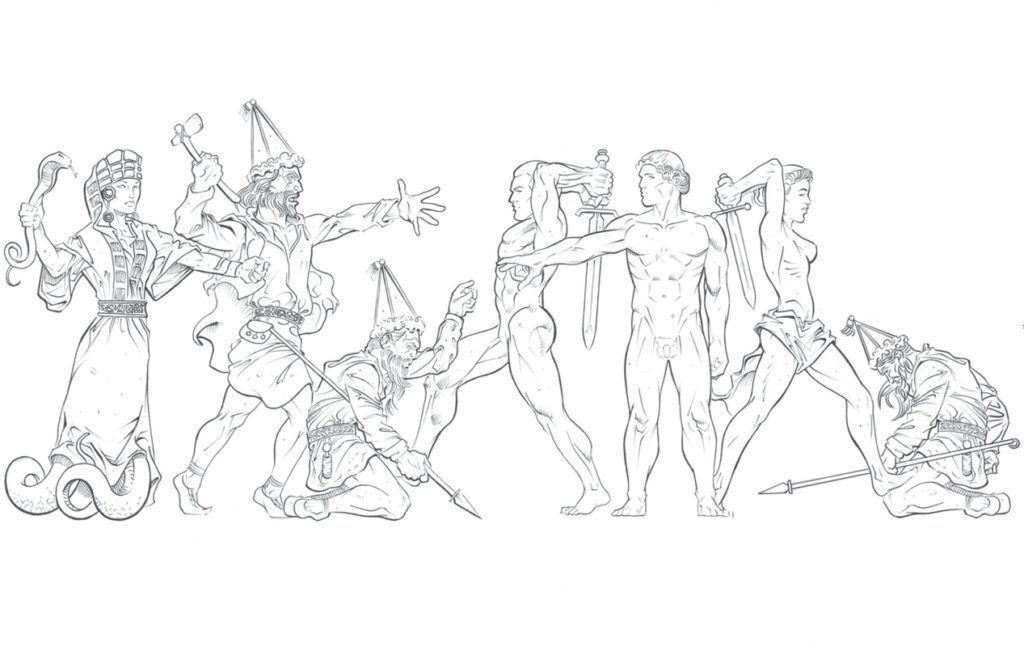Submitted by Jeff on Tue, 19/06/2012 – 05:56
Progress on the art for the Guide to Glorantha progresses rapidly, with my crack team of advisors helping me make the best use possible of our talented artists. Colin Driver and Simon Bray plug along on the maps (more on that in a future post). Here’s a bit of Loskalmi art, depicting King Siglat’s ultimate triumph over the barbarians, inaugurating the Syndics Ban.
Object: This is depicts a high relief (probably very high) marble frieze that adorns the Temple of the Invisible God in Northpoint, Loskalm, a kingdom that somewhat resembles Plato’s Republic. Something similar to the Gigantomachy of the Pergamon Altar (http://www.insecula.com/PhotosNew/00/00/11/39/ME0000113924_3.jpg) or the Elgin Marbles (http://commons.wikimedia.org/wiki/Elgin_Marbles).
Style: Severe Style of Early Classical Greece (http://commons.wikimedia.org/wiki/Category:Olympia_Master). The physical form is idealized, physically perfect, and presented with a certain severity of form. We have two types of figures:
Heroes: The three heroes are the center of the piece. They are physically perfect, calm, idealized, and clearly the winners of the fight. They are all in the prime of life, athletic, and perfect. They are naked to display their perfection. The heroes are of the culture that made the sculpture – a radical egalitarian commonwealth that can be thought of as Plato’s Republic in a fantasy setting. They revere logic and philosophy, and, like Plato, are obsessed with the Ideal Forms of things and concepts.
Barbarians: The barbarians are clothed in decorated leather or skins (think Scythians, or even better – Lapplanders or Sami as depicted by Classical Greeks!). The men are bearded, the woman has wild hair. Their faces snarl and rage, contorting their features (think the way the Greeks depicted the faces of Centaurs in the various depictions of the Centaurmachy (eg., http://upload.wikimedia.org/wikipedia/commons/1/18/Centaur_and_Lapith_in_combat-South_metope-Parthenon-British_Museum.jpg).
The barbarians are the tribal peoples that surround our Plato’s Republic. They are animists and polytheists similar to the various Baltic peoples, and are somewhere between the Neolithic and the Bronze Age. Naturally our wise philosophers celebrate killing them and taking their land.
Figures
I’ve attached a crude sketch called Fronelan Sketch, which crudely depicts the various figures of the sketch.

Fig 1. The Heroic Sorcerer-King. This figure is based on the Apollo from the West Pediment of the Temple of Olympia (http://commons.wikimedia.org/wiki/File:Apollo_Olympia.jpg). He is physically perfect, naked, clean-shaven, wise, and serene. He is casting a spell upon the barbarians that shall bind them in their primitive homelands.
Fig 2. The Heroic Male Guardian. The pose of this figure comes from the Heracles-Cattle of Geryon metope at the Temple of Olympia (http://employees.oneonta.edu/farberas/arth/Images/ARTH209images/Sculpture/classical/Olympia/met_recon2.jpg). Unlike Heracles, the Male Guardian is clean-shaven and prepares to strike down the barbarian with a sword, not a club.
Fig 3. The Heroic Female Guardian. This figure is in the same pose as the Male Guardian. She is female, naked or possibly with a light robe to guard her modesty. In either case, she is muscular and physicallly perfect, but not sexual at all. Like the Male Guardian, she prepares to strike down a barbarian with a club.
Fig 4. Defeated Barbarian. The pose of this figure comes from the Heracles-Cattle of Geryon metope. His spear has been knocked down by the Male Guardian, and he throws his other hand up in the air. The barbarian is bearded and wears barbaric clothes like the Scythians as depicted by the Greeks(http://0.tqn.com/d/arthistory/1/0/i/W/sumex07_04.jpg). Bonus points if he looks reminiscent of a savage Lapplander or Sami people (http://imageshack.us/photo/my-images/815/saam.jpg/) but as depicted by Ancient Greeks.
Fig 5. Angry Barbarian. This figure is an undefeated version of Fig 4. He carries a crude axe made of stone or bronze (http://www.museumsofmayo.com/belcarra/belcarra07.jpg).
Fig 6. Barbarian Witch. This savage shamaness holds a snake and her feet are snake legs! She is trying to cast some evil spell upon our heroic sorcerer-king, but it is clearly doomed to fail. Again, she should look like a Sami/Scythian, as depicted by the ancient Greeks.
Fig 7. Another defeated barbarian. Same as figure 4, but about to be killed by the Female Guardian.
And here is the finished picture:

Submitted by Jeff on Thu, 21/06/2012 – 01:06.
I asked someone at the Temple of the Invisible God at Northpoint, and he said the frieze depicts King Siglat binding the barbarians into their savage lands. I saw no reason to doubt him, as Prince Snodal is always depicted with his cloak and traveler’s hat.
My guide told me that the snake woman was one of the Hykimi Snake Masters, feared magicians that aided the White Bear Empire in its conquests. I found it insulting that the Loskalmi chose to depict the barbarian witch as the generous Seshna Likta; my guide said no insult was intended, but I did not believe him.
Jeff
Editor-in-Chief, Moon Design Publications
Submitted by Daniel Adamov on Thu, 21/06/2012 – 00:58.
For all the emphasis that is sometimes put on the Hindu-like aspects of the New West, I must say I like the Classical Greek sides of it more. I think I really like this one.
The barbarians make me think more of the assorted bunch that came with Black Hralf the Weasel. If they are supposed to be Lapplanders or Sami, then that makes me think more of Uncolings, though they are probably more of a distantly related people (I’d expect Uncolings to have antlers or somesuch, after all :)).
As for the snakes, they can be associated with any Earth goddess, can they not? It really is an interesting figure, though, and definitely made me think of Seshna Likta at first.
That being said, are you sure it is supposed to be Siglat and not Snodal? Siglat, I think, came to power after the war with the barbarians was done. I wonder what he looked like/would have been depicted as, by the way, considering his Altinelan heritage.
Submitted by Herve on Tue, 19/06/2012 – 18:10.
Another exciting and thoughtful piece of work. I like Loskalmi less and less ! Their kind of art reminds me of communist/nazi paintings. Lots of idealized, asexual bodies, emphasis on muscles, expressionless faces (the triumph of Logic), victory over “under-men”, etc. It makes this culture disturbing and highlight this “too good to be true” feeling. Bravo.
Submitted by phf on Tue, 19/06/2012 – 07:59.
Is there a reason the male guardian doesn’t have any genitals? I’m pretty sure the absence will be more striking than if they were shown.
There is a piece of art like that in one of the Sartar books. One of the women depicted has bare breasts but no nipples. It looks very odd. I think artists (or art directors) do us a disservice when they try to sanitize things.
Submitted by metcalph on Tue, 19/06/2012 – 07:05.
I *love* the drawing. I’ve been forewarned about the Nude Loskalmi so it’s not a complete shocker as the Rokari Frieze.
I understand the barbarians are Oranorans or maybe even Yggites rather than Hsunchen but the Snake Woman is a bit of a surprise. The nearest snake cults that I know of are in Seshnela or Ralios. Do we know anything more about her?
